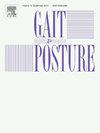Functional task kinematics in older adults: The role of fear of falling and fall history as measured by themovement deviation profile
IF 2.2
3区 医学
Q3 NEUROSCIENCES
引用次数: 0
Abstract
Background
Most falls at home of older adults occur during activities of daily living, with fear of falling (FOF) heightening the risk.
Research question
How does the fear of falling influence the kinematics of functional tasks in faller and non-faller older people?
Methods
A total of 68 participants aged 60 and older were divided into four groups: NF-lowFOF (non-faller with low fear, control group), NF-highFOF (non-faller with high fear), F-lowFOF (faller with low fear), and F-highFOF (faller with high fear), with 17 individuals in each group. The three-dimensional kinematics data were analyzed using a single number gait deviation index, the mean Movement Deviation Profile (MDPmean), to identify which task and group had the greatest difference by comparing the Z-scores of the MDPmean. Multivariate analysis and Bonferroni post hoc tests (p < 0.05) were employed to analyze group interactions.
Results
Significant differences in kinematics were observed across all functional tasks. The largest effect size between the control group and the other groups for each functional task were descending and ascending stairs, sitting to stand, walking turn and gait in F-highFOF, and standing to sit in F-lowFOF. The time to perform each task didn’t differ between the groups.
Significance
FOF (whether high or low) can significantly impact the kinematics of functional tasks in both faller and non-faller older adults. Therefore, assessing FOF in this population is crucial to prevent falls and promote rehabilitation, especially in non-faller older adults with high FOF.
背景老年人在家跌倒大多发生在日常生活活动中,而跌倒恐惧(FOF)会增加跌倒风险。研究问题跌倒恐惧如何影响跌倒者和非跌倒者的功能任务运动学? 方法将 68 名 60 岁及以上的参与者分为四组:NF-lowFOF(低恐惧的非跌倒者,对照组)、NF-highFOF(高恐惧的非跌倒者)、F-lowFOF(低恐惧的跌倒者)和F-highFOF(高恐惧的跌倒者),每组 17 人。三维运动学数据采用单数步态偏差指数,即平均运动偏差曲线(MDPmean)进行分析,通过比较 MDPmean 的 Z 值,确定哪项任务和哪组的差异最大。结果在所有功能任务中都观察到了运动学上的显著差异。在每项功能任务中,对照组与其他组之间影响最大的是下楼梯和上楼梯、坐立、行走转弯和步态(F-highFOF),以及站立到坐立(F-lowFOF)。完成每项任务所需的时间在各组之间没有差异。因此,在这一人群中评估FOF对于预防跌倒和促进康复至关重要,尤其是对于FOF较高的非跌倒老年人。
本文章由计算机程序翻译,如有差异,请以英文原文为准。
求助全文
约1分钟内获得全文
求助全文
来源期刊

Gait & posture
医学-神经科学
CiteScore
4.70
自引率
12.50%
发文量
616
审稿时长
6 months
期刊介绍:
Gait & Posture is a vehicle for the publication of up-to-date basic and clinical research on all aspects of locomotion and balance.
The topics covered include: Techniques for the measurement of gait and posture, and the standardization of results presentation; Studies of normal and pathological gait; Treatment of gait and postural abnormalities; Biomechanical and theoretical approaches to gait and posture; Mathematical models of joint and muscle mechanics; Neurological and musculoskeletal function in gait and posture; The evolution of upright posture and bipedal locomotion; Adaptations of carrying loads, walking on uneven surfaces, climbing stairs etc; spinal biomechanics only if they are directly related to gait and/or posture and are of general interest to our readers; The effect of aging and development on gait and posture; Psychological and cultural aspects of gait; Patient education.
 求助内容:
求助内容: 应助结果提醒方式:
应助结果提醒方式:


